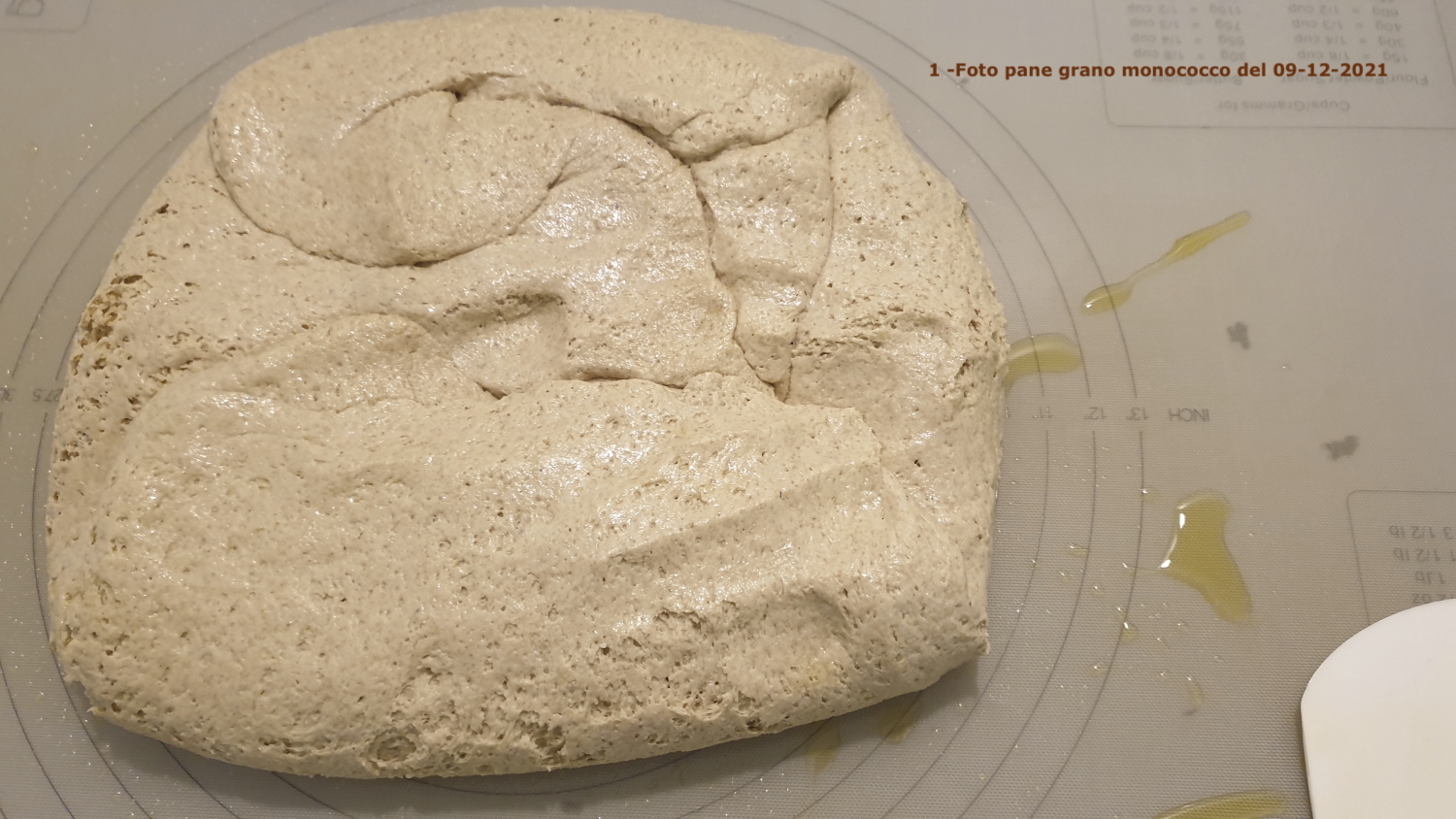Einkorn-Based Breads: anti-inflammatory effect. (Fabiana Antognoni et al. Nutrients 11-11-2017)
Abstract: Nowadays the high nutritional value of whole grains is recognized, and there is an increasing interest in the ancient varieties for producing wholegrain food products with enhanced nutritional characteristics. Among ancient crops, einkorn could represent a valid alternative. In this work, einkorn flours were analyzed for their content in carotenoids and in free and bound phenolic acids, and compared to wheat flours. The most promising flours were used to produce conventional and sourdough fermented breads. Breads were in vitro digested, and characterized before and after digestion. The four breads having the best characteristics were selected, and the product of their digestion was used to evaluate their anti-inflammatory effect using Caco-2 cells. Our results confirm the higher carotenoid levels in einkorn than in modern wheats, and the effectiveness of sourdough fermentation in maintaining these levels, despite the longer exposure to atmospheric oxygen. Moreover, in cultured cells einkorn bread evidenced an anti-inflammatory effect, although masked by the effect of digestive fluid. This study represents the first integrated evaluation of the potential health benefit of einkorn-based bakery products compared to wheat-based ones, and contributes to our knowledge of ancient grains.
Several studies have shown a clear correlation between the consumption of wholegrain and a reduced risk of cardiovascular diseases [1,2], diabetes [3], and some types of cancer [4]. The beneficial properties of wholegrain are mainly ascribed to their micronutrient and phytochemical content [5–7]. Cereals are among the richest food in phenolic acids, their content being comparable with or even higher than that found in berries, fruits, and vegetables [8]. In addition, some cereals are rich in lutein and zeaxanthin [9,10]. Micronutrients and phytochemicals are chiefly concentrated in the outer layers of grains [11], and this could explain the preventive effects associated with high wholegrain consumption [12]. Nowadays, the higher nutritional value of wholegrain compared to refined ones is recognized [13], and there is an increasing interest in ancient crops as source of wholegrain flours [14].
Einkorn (Triticum monococcum L. ssp. monococcum) is an ancient crop. Compared to polyploid wheats it has a higher content of proteins, polyunsaturated fatty acids, fructans, and phytochemicals as tocols, carotenoids, alkylresorcinols, phytosterols, and a lower α-, β-amylase and lipoxygenase activities [15]. In addition, einkorn expresses very few T-cell stimulatory gluten peptides [16]. Einkorn could represent a valid alternative for producing functional baked products.
In bakery, processing could contribute to functionality [17,18]. Sourdough fermentation, involving the inter-relation between microbial metabolism and cereal enzymes, has been shown to greatly affect the functional features of leavened baked goods [19]. This type of fermentation may produce new nutritionally active molecules such as functional peptides and amino acid derivatives [20,21], deriving from either the bacterial hydrolytic activity [20] or from their own synthetic pathways [22]. To exert a positive action in the human body, bioactive compounds must be hydrolyzed from the food matrix, and be absorbed in the intestine. The bioaccessibility of bioactive compounds, i.e., the percentage released from the food matrix and made available for uptake by the intestinal mucosa, is an important parameter that can be influenced by many different factors including the food matrix and the food processing [23,24]. Fermentation by lactic acid bacteria may improve nutrient bioaccessibility and produce compounds with anti-oxidant and anti-inflammatory activity [19]. Sourdough lactic acid bacteria have been reported to release or synthesize antioxidant and anti-inflammatory peptides during fermentation of cereal flours [20].
In this work, different wheat and einkorn flours were analyzed for their content in carotenoids and phenolic acids. The richest in these functional compounds were selected, and used to bake breads with two different fermentation procedures (conventional and sourdough).
Breads were digested in vitro using a dynamic gastro-intestinal digestor, and characterized before and after digestion. Based on integrated results, four breads were selected, and the product of their intestinal digestion was supplemented to Caco-2 intestinal cells. Cells were exposed to inflammatory stress, and the effect of supplementation on different inflammation markers was assessed.
Overall, this study has evaluated how the type of flour and the type of fermentation can influence the nutritional features of bread, and the bioaccessibility and anti-inflammatory effects of its functional compounds. The combination of different results provides an integrated vision supporting the possible health benefits of einkorn-based bread.
References
1. Zong, G.; Gao, A.; Hu, F.B.; Sun, Q. Whole grain intake and mortality from all causes, cardiovascular disease, and cancer: A meta-analysis of prospective cohort studies. Circulation 2016, 133, 2370–2380. [CrossRef] [PubMed]
2. Aune, D.; Keum, N.; Giovannucci, E.; Fadnes, L.T.; Boffetta, P.; Greenwood, D.C.; Tonstad, S.; Vatten, L.J.; Riboli, E.; Norat, T. Whole grain consumption and risk of cardiovascular disease, cancer, and all cause and cause specific mortality: Systematic review and dose-response meta-analysis of prospective studies. BMJ 2016, 353, i2716. [CrossRef] [PubMed]
3. Ye, E.Q.; Chacko, S.A.; Chou, E.L.; Kugizaki, M.; Liu, S. Greater whole-grain intake is associated with lower risk of type 2 diabetes, cardiovascular disease, and weight gain. J. Nutr. 2012, 142, 1304–1313. [CrossRef] [PubMed]
4. Kyrø, C.; Skeie, G.; Loft, S.; Landberg, R.; Christensen, J.; Lund, E.; Nilsson, L.M.; Palmqvist, R.; Tjønneland, A.; Olsen, A. Intake of whole grains from different cereal and food sources and incidence of colorectal cancer in the Scandinavian HELGA cohort. Cancer Causes Control 2013, 24, 1363–1374. [CrossRef] [PubMed]
5. Adom, K.K.; Liu, R.H. Antioxidant activity of grains. J. Agric. Food Chem. 2002, 50, 6182–6187. [CrossRef] [PubMed]
6. Adom, K.K.; Sorrells, M.E.; Liu, R.H. Phytochemical profiles and antioxidant activity of wheat varieties.
J. Agric. Food Chem. 2003, 51, 7825–7834. [CrossRef] [PubMed]
7. Abdel-Aal, E.S.M.; Young, J.C.; Rabalski, I.; Hucl, P.; Frégeau-Reid, J. Identification and quantification of seed carotenoids in selected wheat species. J. Agric. Food Chem. 2007, 55, 787–794. [CrossRef] [PubMed]
8. Perez-Jimenez, J.; Neveu, V.; Vos, F.; Scalbert, A. Systematic analysis of the content of 502 polyphenols in 452 foods and beverages: An application of the Phenol−Explorer database. J. Agric. Food Chem. 2010, 58, 4959–4969. [CrossRef] [PubMed]
9. Abdel-Aal, E.S.M.; Young, J.C.; Wood, P.J.; Rabalski, I.; Hucl, P.; Fregeau-Reid, J. Einkorn: A potential candidate for developing high lutein wheat. Cereal Chem. 2002, 79, 455–457. [CrossRef]
10. Humphries, J.M.; Khachik, F. Distribution of lutein, zeaxanthin and related geometrical isomers in fruit, vegetables, wheat and pasta products. J. Agric. Food Chem. 2003, 51, 1322–1327. [CrossRef] [PubMed]
11. Sosulski, F.; Krygier, K.; Hogge, L. Free, esterified, and insoluble-bound phenolic acids. 3. Composition of phenolic acids in cereal and potato flour. J. Agric. Food Chem. 1982, 30, 337–340. [CrossRef]
12. Poutanen, K.; Shepherd, R.; Shewry, P.R.; Delcour, J.A.; Bjorck, I.; Van Der Kamp, J.W. Beyond whole grain:
The European HEALTH GRAIN project aims at healthier cereal foods. Cereal Foods World 2008, 53, 32–35. [CrossRef]
13. Slavin, J. Why whole grains are protective: Biological mechanisms. Proc. Nutr. Soc. 2003, 62, 129–134.
[CrossRef] [PubMed]
14. Bordoni, A.; Danesi, F.; Di Nunzio, M.; Taccari, A.; Valli, V. Ancient wheat and health: A legend or the reality?
A review on KAMUT khorasan wheat. Int. J. Food Sci. Nutr. 2016, 28, 1–9. [CrossRef] [PubMed]
15. Hidalgo, A.; Brandolini, A. Nutritional properties of einkorn wheat (Triticum monococcum L.). J. Sci. Food Agric.
2014, 94, 601–612. [CrossRef] [PubMed] Nutrients 2017, 9, 1232
15 of 17
16. Molberg, Ø.; Uhlen, A.K.; Jensen, T.; Flæte, N.S.; Fleckenstein, B.; Arentz-Hansen, H.; Raki, M.; Lundin, K.E.A.; Sollid, L.M. Mapping of gluten T-cell epitopes in the bread wheat ancestors: Implication for celiac disease. Gastroenterology 2005, 128, 393–401. [CrossRef] [PubMed]
17. Sánchez-Pardo, M.E.; Blancas-Nápoles, J.A.; Vázquez-Landaverde, P.A.; Nari, A.; Taglieri, I.; Ortiz-Moreno, A.; Mayorga-Reyes, L.; Sanmartin, C.; Bermúdez-Humarán, L.G.; Torres-Maravilla, E. The use of Mexican xaxtle as leavening agent in Italian straight dough bread making to produce pulque bread. Agrochimica 2016, 60, 329–342.
18. Venturi, F.; Sanmartin, C.; Taglieri, I.; Nari, A.; Andrich, G.; Zinnai, A. Effect of the baking process on artisanal sourdough bread-making: A technological and sensory evaluation. Agrochimica 2016, 60, 222–234.
19. Ganzle, M.G. Enzymatic and bacterial conversions during sourdough fermentation. Food Microbiol. 2014, 37, 2–10. [CrossRef] [PubMed]
20. Gobbetti, M.; Rizzello, G.C.; Di Cagno, R.; De Angelis, M. How the sourdough may affect the functional features of leavened baked goods. Food Microbiol. 2014, 37, 30–40. [CrossRef] [PubMed]


